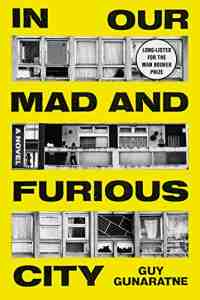In Our Mad and Furious City by Guy Gunaratne
 Monday, December 10, 2018 at 7:30AM
Monday, December 10, 2018 at 7:30AM 
First published in Great Britain in 2018; published by Farrar, Straus and Giroux on December 11, 2018
Conflict among cultures is not the Clash of Civilizations that hysteria-fueled commentators anxiously await, but there is little doubt that people holding different worldviews sometimes view each other with hostility rather than understanding. In Our Mad and Furious City examines those divides and the bridges that cross them in a story that covers the lives of a few diverse characters in London over a short period of time.
The London of In Our Mad and Furious City is divided in many ways, including the division between those who live off-Estate and those who don’t. “What makes me off-Estate is where I live,” Selvon says, “but truthfully what makes me off-Estate is more than that, ennet.”
The lives of several characters are simultaneously revealed in the novel. Some live in Stones Estate, others do not, but all perceive boundaries that are not easily crossed.
Nelson, once homesick for the West Indies, now worries about his son as he rolls his wheelchair past the Estate. Nelson still remembers the first time he saw KBW (“Keep Britain White”) graffiti. “Was an ugliness in this Britain, I feel it then. But I had not learn it yet. … To see it there, writ across the brick, it have me numb and leave me feeling a sorta deep-down shame. Sorta shame the Lord give you when you love a wretched thing. Was how it feel like when I realize that this Britain here did not love me back, no matter how much I feel for it.”
The tension has expanded since Nelson came to London, driven by divisions not just of color but of religion. Guy Gunaratne explores those divisions from the perspectives of his diverse characters, none of whom particularly want to be divided. As Nelson learned in his youth, hate breeds hate, turning good people bad unless good people can find a way to resist.
Nelson’s son Selvon plays football in the Estate with his friends Yusuf and Ardan. Selvon is smart and plans to go to university. Whether he has a future will depend in part on how he lives his life and in part on fate. Selvon and all the other characters are living in a dangerous world.
Yusuf lives in the Estate. He keeps his head down, avoiding both the imams and the anti-Muslim marches. To Yusuf, the Estate is a world away from Pakistan, but Pakistan is a world to which he might be forced to return.
Ardan, a lover of rap in any language, sits on the West Block rooftop to write music. If Ardan has a future beyond minimum wage, it is in music, but to reach that future he’ll need to overcome his fear. Ardan’s father has disappeared. His mother Caroline, a Belfast transplant who had a complicated relationship alcohol as well as history, lives with him in West Block. She has disturbing memories of the Troubles that, in some ways, parallel her current life in London. She is certain that violence follows her and that God doesn’t care.
In Our Mad and Furious City raises enduring questions about the awful things people do in the name of religion or because of another person’s religion. If religion is so often perceived as a vehicle that justifies hatred and violence, would the world be better off without it? The same questions, seemingly relevant to every time and place, relate to violence based on race and ethnicity. The riots that Nelson experienced in the West Indies, that Caroline feared in Northern Ireland, and that affect the lives of the characters as the novel nears its end all echo the same lunacy. At the same time, the story suggests that cause and effect can be more complex issues than observers might assume.
Characters speak in dialects that may require the reader to guess at word meanings (or, when all else fails, to Google). Most of the characters are young and they share the common language of youth. The dialects add to the story’s authenticity and give the book a nice rhythm.
The plot is eventful in an understated way. Gunaratne could have taken the plot over the top but he allowed himself only one large moment of drama. It is dramatic in a way that seems inevitable given the story that precede it. For the most part, the story is very personal, told from the perspectives of people who want to come together, to avoid the senseless divisions that seem to require them to take a side. The story’s sadness is balanced by hope, the possibility that the world can become a better place, one human at a time
RECOMMENDED
Reader Comments